Assignment on Leading and Management of Organizational Changes
VerifiedAdded on 2022/08/25
|10
|2606
|24
AI Summary
Contribute Materials
Your contribution can guide someone’s learning journey. Share your
documents today.
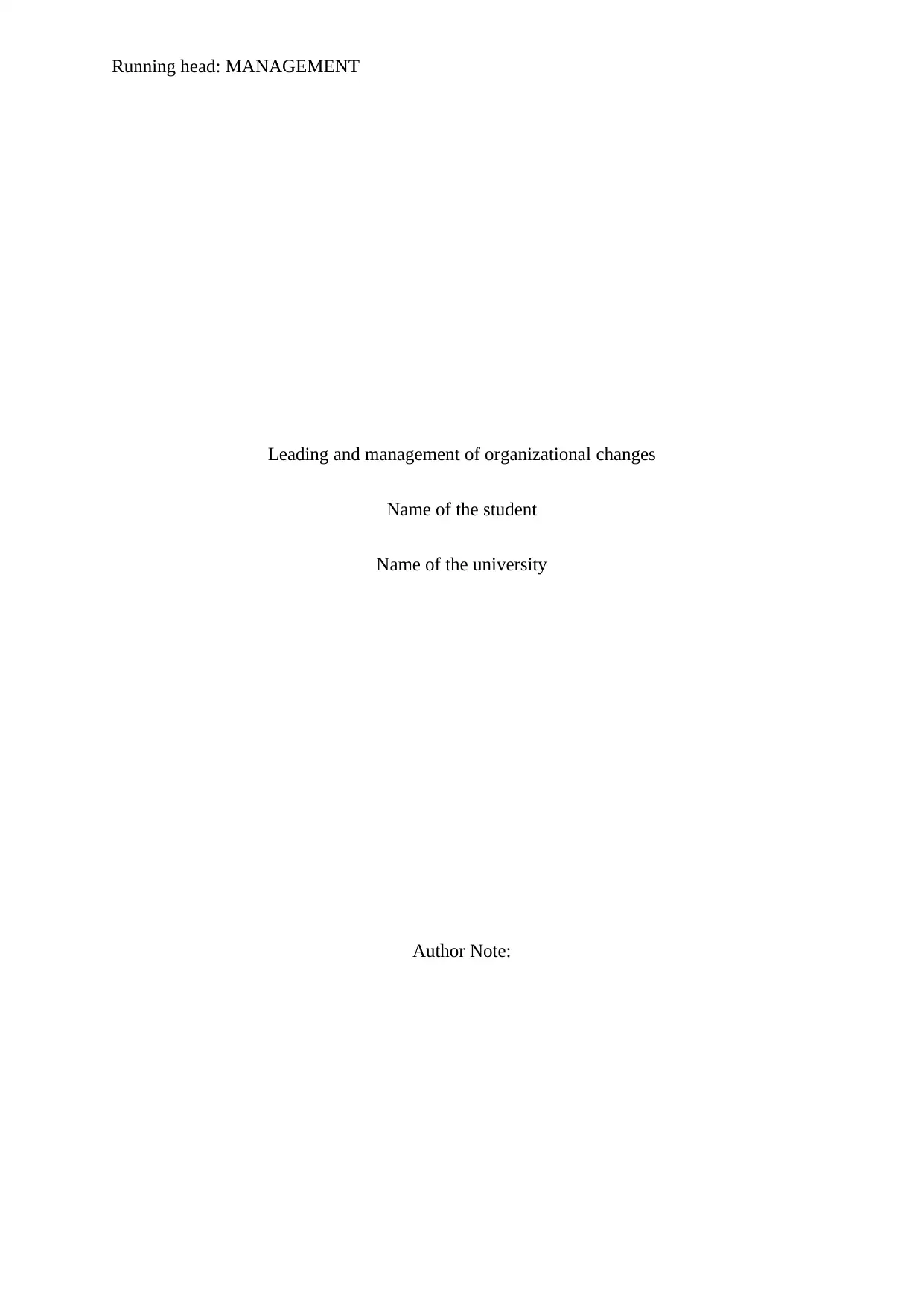
Running head: MANAGEMENT
Leading and management of organizational changes
Name of the student
Name of the university
Author Note:
Leading and management of organizational changes
Name of the student
Name of the university
Author Note:
Secure Best Marks with AI Grader
Need help grading? Try our AI Grader for instant feedback on your assignments.
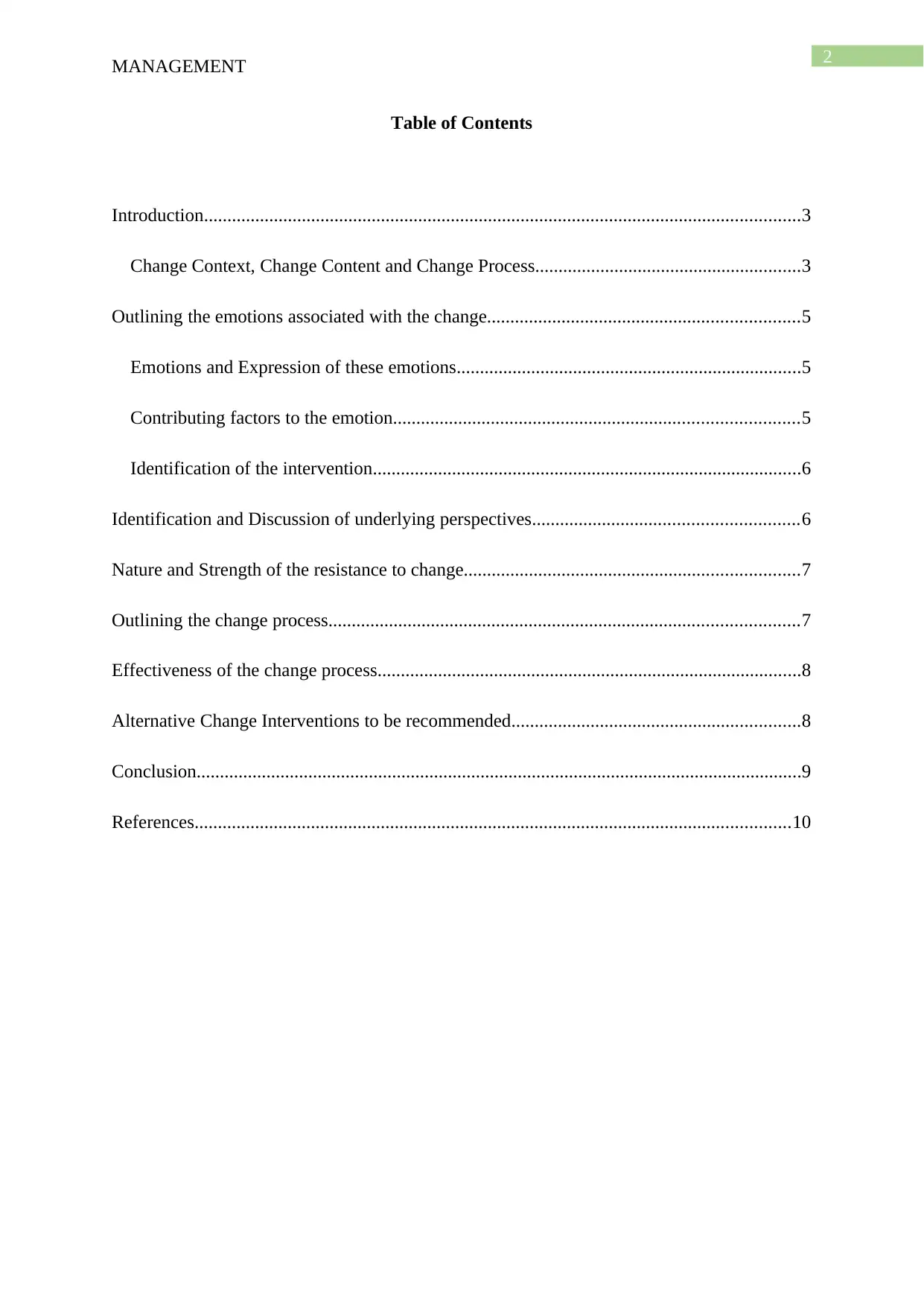
2
MANAGEMENT
Table of Contents
Introduction................................................................................................................................3
Change Context, Change Content and Change Process.........................................................3
Outlining the emotions associated with the change...................................................................5
Emotions and Expression of these emotions..........................................................................5
Contributing factors to the emotion.......................................................................................5
Identification of the intervention............................................................................................6
Identification and Discussion of underlying perspectives.........................................................6
Nature and Strength of the resistance to change........................................................................7
Outlining the change process.....................................................................................................7
Effectiveness of the change process...........................................................................................8
Alternative Change Interventions to be recommended..............................................................8
Conclusion..................................................................................................................................9
References................................................................................................................................10
MANAGEMENT
Table of Contents
Introduction................................................................................................................................3
Change Context, Change Content and Change Process.........................................................3
Outlining the emotions associated with the change...................................................................5
Emotions and Expression of these emotions..........................................................................5
Contributing factors to the emotion.......................................................................................5
Identification of the intervention............................................................................................6
Identification and Discussion of underlying perspectives.........................................................6
Nature and Strength of the resistance to change........................................................................7
Outlining the change process.....................................................................................................7
Effectiveness of the change process...........................................................................................8
Alternative Change Interventions to be recommended..............................................................8
Conclusion..................................................................................................................................9
References................................................................................................................................10
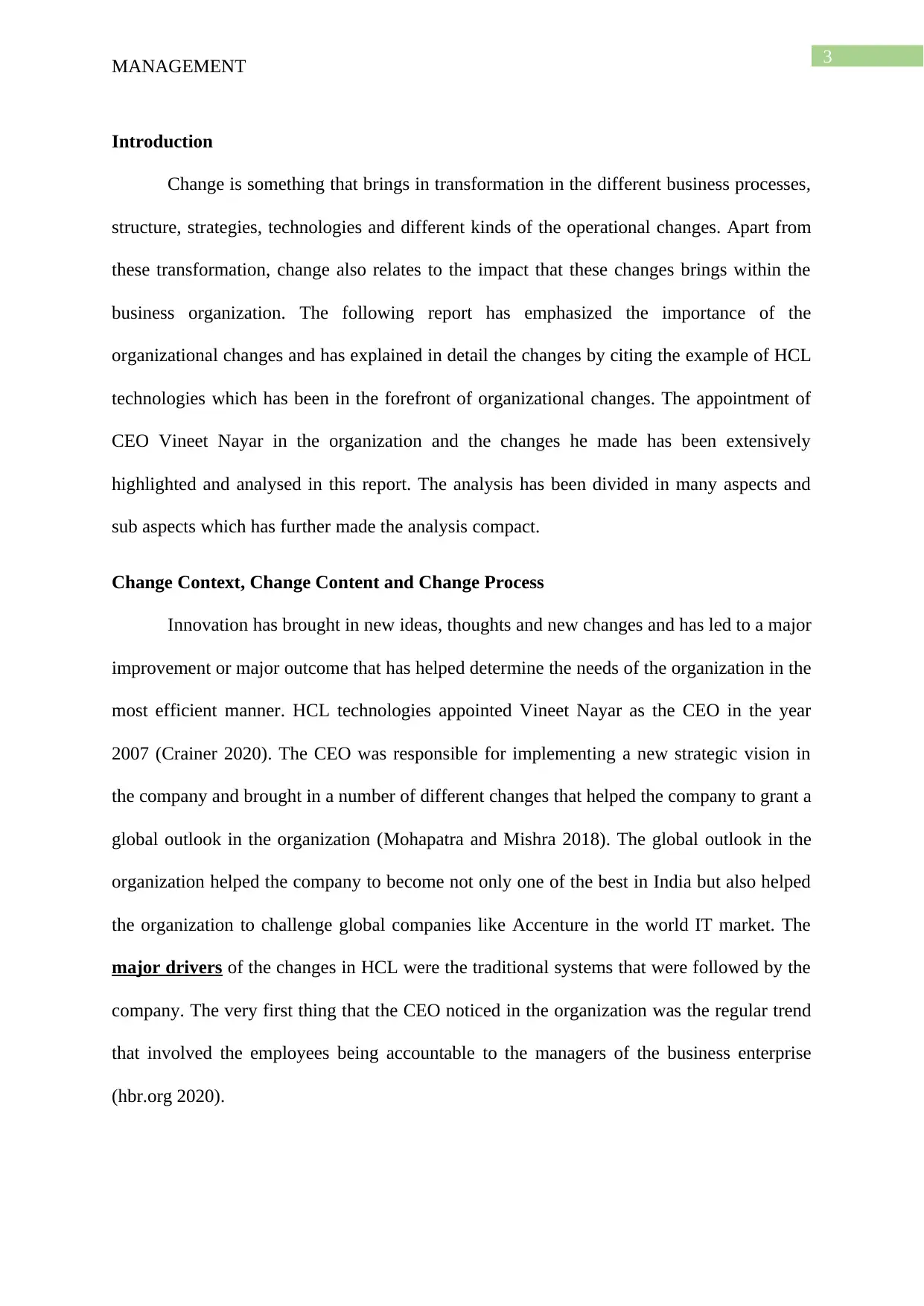
3
MANAGEMENT
Introduction
Change is something that brings in transformation in the different business processes,
structure, strategies, technologies and different kinds of the operational changes. Apart from
these transformation, change also relates to the impact that these changes brings within the
business organization. The following report has emphasized the importance of the
organizational changes and has explained in detail the changes by citing the example of HCL
technologies which has been in the forefront of organizational changes. The appointment of
CEO Vineet Nayar in the organization and the changes he made has been extensively
highlighted and analysed in this report. The analysis has been divided in many aspects and
sub aspects which has further made the analysis compact.
Change Context, Change Content and Change Process
Innovation has brought in new ideas, thoughts and new changes and has led to a major
improvement or major outcome that has helped determine the needs of the organization in the
most efficient manner. HCL technologies appointed Vineet Nayar as the CEO in the year
2007 (Crainer 2020). The CEO was responsible for implementing a new strategic vision in
the company and brought in a number of different changes that helped the company to grant a
global outlook in the organization (Mohapatra and Mishra 2018). The global outlook in the
organization helped the company to become not only one of the best in India but also helped
the organization to challenge global companies like Accenture in the world IT market. The
major drivers of the changes in HCL were the traditional systems that were followed by the
company. The very first thing that the CEO noticed in the organization was the regular trend
that involved the employees being accountable to the managers of the business enterprise
(hbr.org 2020).
MANAGEMENT
Introduction
Change is something that brings in transformation in the different business processes,
structure, strategies, technologies and different kinds of the operational changes. Apart from
these transformation, change also relates to the impact that these changes brings within the
business organization. The following report has emphasized the importance of the
organizational changes and has explained in detail the changes by citing the example of HCL
technologies which has been in the forefront of organizational changes. The appointment of
CEO Vineet Nayar in the organization and the changes he made has been extensively
highlighted and analysed in this report. The analysis has been divided in many aspects and
sub aspects which has further made the analysis compact.
Change Context, Change Content and Change Process
Innovation has brought in new ideas, thoughts and new changes and has led to a major
improvement or major outcome that has helped determine the needs of the organization in the
most efficient manner. HCL technologies appointed Vineet Nayar as the CEO in the year
2007 (Crainer 2020). The CEO was responsible for implementing a new strategic vision in
the company and brought in a number of different changes that helped the company to grant a
global outlook in the organization (Mohapatra and Mishra 2018). The global outlook in the
organization helped the company to become not only one of the best in India but also helped
the organization to challenge global companies like Accenture in the world IT market. The
major drivers of the changes in HCL were the traditional systems that were followed by the
company. The very first thing that the CEO noticed in the organization was the regular trend
that involved the employees being accountable to the managers of the business enterprise
(hbr.org 2020).
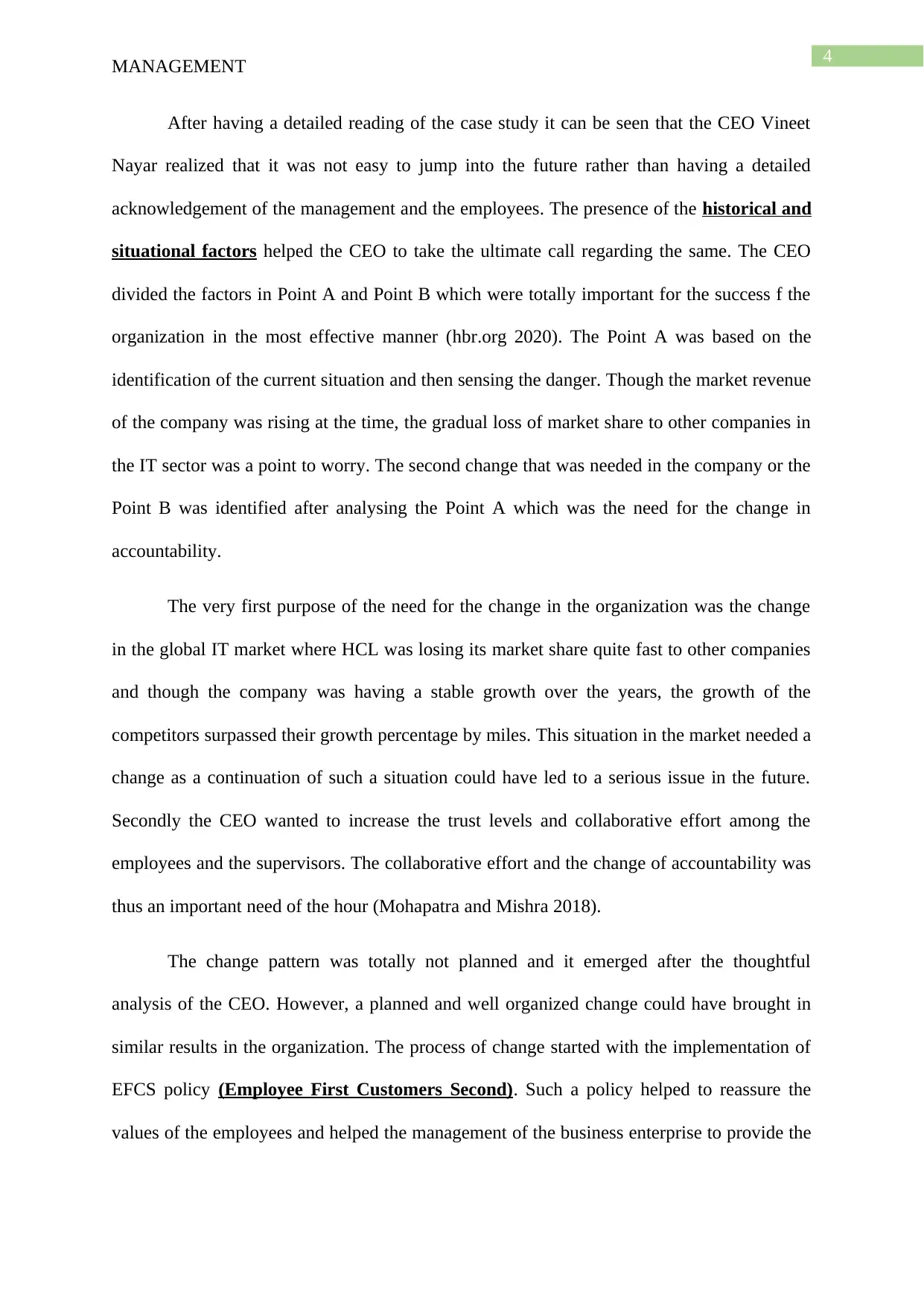
4
MANAGEMENT
After having a detailed reading of the case study it can be seen that the CEO Vineet
Nayar realized that it was not easy to jump into the future rather than having a detailed
acknowledgement of the management and the employees. The presence of the historical and
situational factors helped the CEO to take the ultimate call regarding the same. The CEO
divided the factors in Point A and Point B which were totally important for the success f the
organization in the most effective manner (hbr.org 2020). The Point A was based on the
identification of the current situation and then sensing the danger. Though the market revenue
of the company was rising at the time, the gradual loss of market share to other companies in
the IT sector was a point to worry. The second change that was needed in the company or the
Point B was identified after analysing the Point A which was the need for the change in
accountability.
The very first purpose of the need for the change in the organization was the change
in the global IT market where HCL was losing its market share quite fast to other companies
and though the company was having a stable growth over the years, the growth of the
competitors surpassed their growth percentage by miles. This situation in the market needed a
change as a continuation of such a situation could have led to a serious issue in the future.
Secondly the CEO wanted to increase the trust levels and collaborative effort among the
employees and the supervisors. The collaborative effort and the change of accountability was
thus an important need of the hour (Mohapatra and Mishra 2018).
The change pattern was totally not planned and it emerged after the thoughtful
analysis of the CEO. However, a planned and well organized change could have brought in
similar results in the organization. The process of change started with the implementation of
EFCS policy (Employee First Customers Second). Such a policy helped to reassure the
values of the employees and helped the management of the business enterprise to provide the
MANAGEMENT
After having a detailed reading of the case study it can be seen that the CEO Vineet
Nayar realized that it was not easy to jump into the future rather than having a detailed
acknowledgement of the management and the employees. The presence of the historical and
situational factors helped the CEO to take the ultimate call regarding the same. The CEO
divided the factors in Point A and Point B which were totally important for the success f the
organization in the most effective manner (hbr.org 2020). The Point A was based on the
identification of the current situation and then sensing the danger. Though the market revenue
of the company was rising at the time, the gradual loss of market share to other companies in
the IT sector was a point to worry. The second change that was needed in the company or the
Point B was identified after analysing the Point A which was the need for the change in
accountability.
The very first purpose of the need for the change in the organization was the change
in the global IT market where HCL was losing its market share quite fast to other companies
and though the company was having a stable growth over the years, the growth of the
competitors surpassed their growth percentage by miles. This situation in the market needed a
change as a continuation of such a situation could have led to a serious issue in the future.
Secondly the CEO wanted to increase the trust levels and collaborative effort among the
employees and the supervisors. The collaborative effort and the change of accountability was
thus an important need of the hour (Mohapatra and Mishra 2018).
The change pattern was totally not planned and it emerged after the thoughtful
analysis of the CEO. However, a planned and well organized change could have brought in
similar results in the organization. The process of change started with the implementation of
EFCS policy (Employee First Customers Second). Such a policy helped to reassure the
values of the employees and helped the management of the business enterprise to provide the
Secure Best Marks with AI Grader
Need help grading? Try our AI Grader for instant feedback on your assignments.
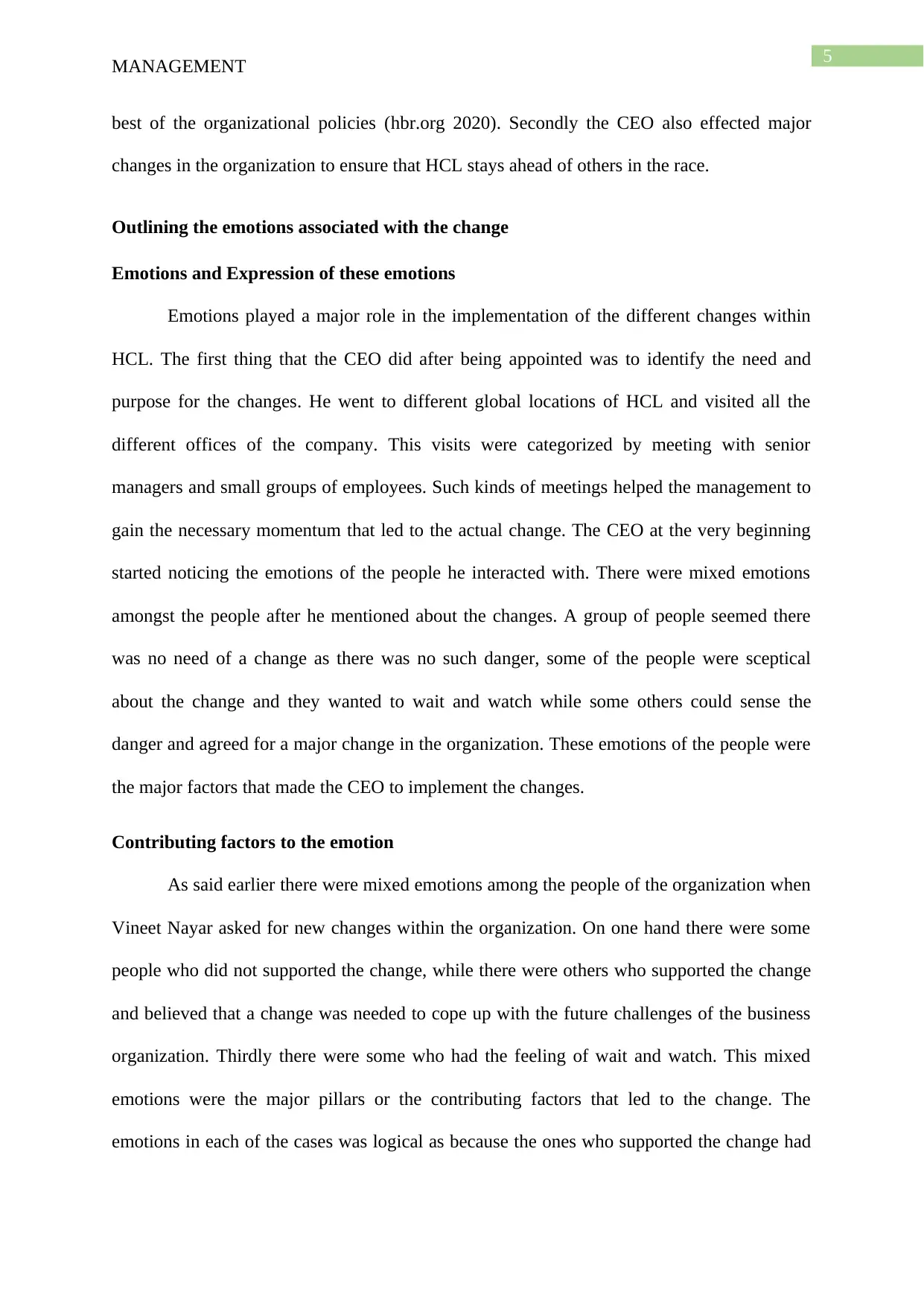
5
MANAGEMENT
best of the organizational policies (hbr.org 2020). Secondly the CEO also effected major
changes in the organization to ensure that HCL stays ahead of others in the race.
Outlining the emotions associated with the change
Emotions and Expression of these emotions
Emotions played a major role in the implementation of the different changes within
HCL. The first thing that the CEO did after being appointed was to identify the need and
purpose for the changes. He went to different global locations of HCL and visited all the
different offices of the company. This visits were categorized by meeting with senior
managers and small groups of employees. Such kinds of meetings helped the management to
gain the necessary momentum that led to the actual change. The CEO at the very beginning
started noticing the emotions of the people he interacted with. There were mixed emotions
amongst the people after he mentioned about the changes. A group of people seemed there
was no need of a change as there was no such danger, some of the people were sceptical
about the change and they wanted to wait and watch while some others could sense the
danger and agreed for a major change in the organization. These emotions of the people were
the major factors that made the CEO to implement the changes.
Contributing factors to the emotion
As said earlier there were mixed emotions among the people of the organization when
Vineet Nayar asked for new changes within the organization. On one hand there were some
people who did not supported the change, while there were others who supported the change
and believed that a change was needed to cope up with the future challenges of the business
organization. Thirdly there were some who had the feeling of wait and watch. This mixed
emotions were the major pillars or the contributing factors that led to the change. The
emotions in each of the cases was logical as because the ones who supported the change had
MANAGEMENT
best of the organizational policies (hbr.org 2020). Secondly the CEO also effected major
changes in the organization to ensure that HCL stays ahead of others in the race.
Outlining the emotions associated with the change
Emotions and Expression of these emotions
Emotions played a major role in the implementation of the different changes within
HCL. The first thing that the CEO did after being appointed was to identify the need and
purpose for the changes. He went to different global locations of HCL and visited all the
different offices of the company. This visits were categorized by meeting with senior
managers and small groups of employees. Such kinds of meetings helped the management to
gain the necessary momentum that led to the actual change. The CEO at the very beginning
started noticing the emotions of the people he interacted with. There were mixed emotions
amongst the people after he mentioned about the changes. A group of people seemed there
was no need of a change as there was no such danger, some of the people were sceptical
about the change and they wanted to wait and watch while some others could sense the
danger and agreed for a major change in the organization. These emotions of the people were
the major factors that made the CEO to implement the changes.
Contributing factors to the emotion
As said earlier there were mixed emotions among the people of the organization when
Vineet Nayar asked for new changes within the organization. On one hand there were some
people who did not supported the change, while there were others who supported the change
and believed that a change was needed to cope up with the future challenges of the business
organization. Thirdly there were some who had the feeling of wait and watch. This mixed
emotions were the major pillars or the contributing factors that led to the change. The
emotions in each of the cases was logical as because the ones who supported the change had
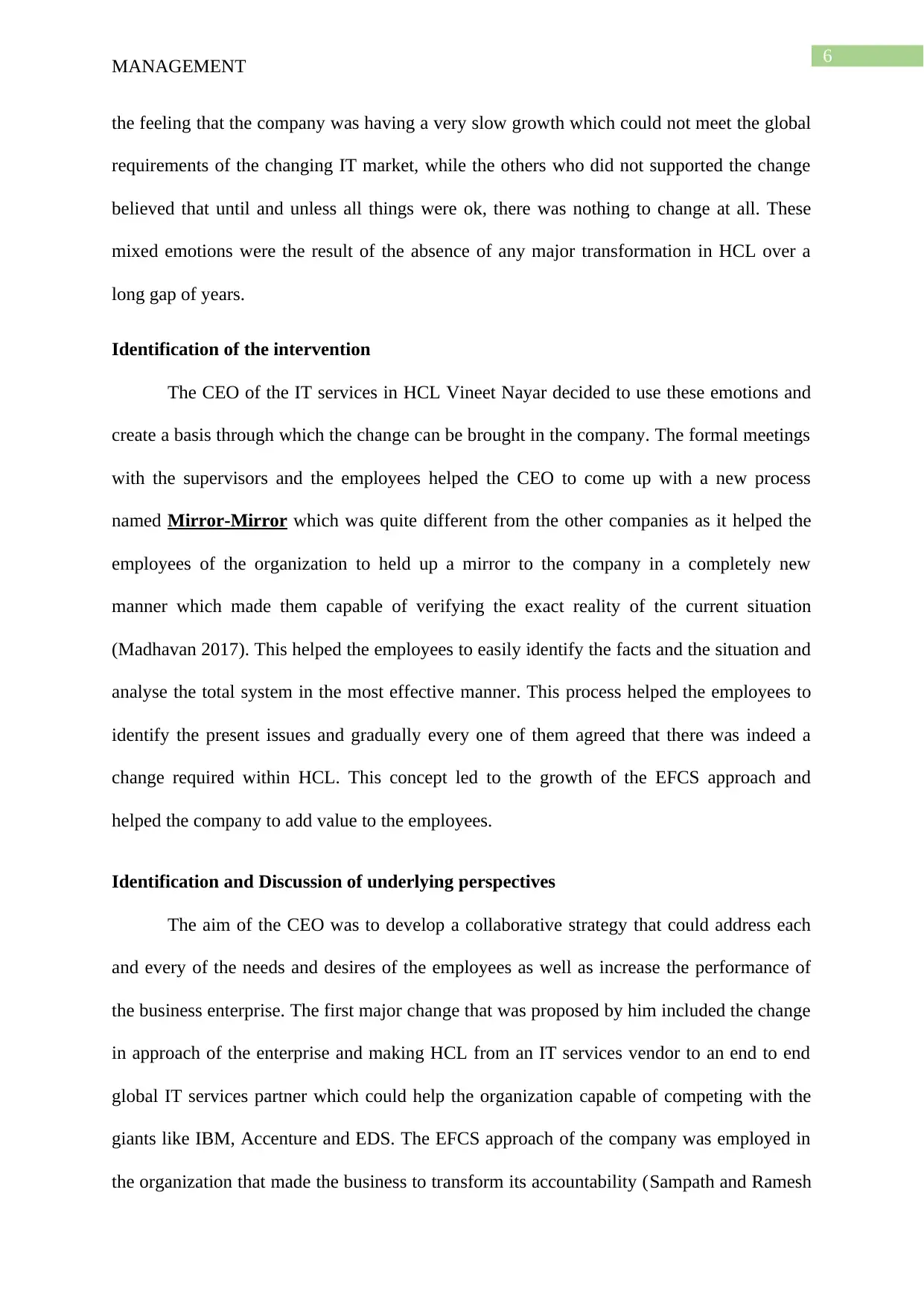
6
MANAGEMENT
the feeling that the company was having a very slow growth which could not meet the global
requirements of the changing IT market, while the others who did not supported the change
believed that until and unless all things were ok, there was nothing to change at all. These
mixed emotions were the result of the absence of any major transformation in HCL over a
long gap of years.
Identification of the intervention
The CEO of the IT services in HCL Vineet Nayar decided to use these emotions and
create a basis through which the change can be brought in the company. The formal meetings
with the supervisors and the employees helped the CEO to come up with a new process
named Mirror-Mirror which was quite different from the other companies as it helped the
employees of the organization to held up a mirror to the company in a completely new
manner which made them capable of verifying the exact reality of the current situation
(Madhavan 2017). This helped the employees to easily identify the facts and the situation and
analyse the total system in the most effective manner. This process helped the employees to
identify the present issues and gradually every one of them agreed that there was indeed a
change required within HCL. This concept led to the growth of the EFCS approach and
helped the company to add value to the employees.
Identification and Discussion of underlying perspectives
The aim of the CEO was to develop a collaborative strategy that could address each
and every of the needs and desires of the employees as well as increase the performance of
the business enterprise. The first major change that was proposed by him included the change
in approach of the enterprise and making HCL from an IT services vendor to an end to end
global IT services partner which could help the organization capable of competing with the
giants like IBM, Accenture and EDS. The EFCS approach of the company was employed in
the organization that made the business to transform its accountability (Sampath and Ramesh
MANAGEMENT
the feeling that the company was having a very slow growth which could not meet the global
requirements of the changing IT market, while the others who did not supported the change
believed that until and unless all things were ok, there was nothing to change at all. These
mixed emotions were the result of the absence of any major transformation in HCL over a
long gap of years.
Identification of the intervention
The CEO of the IT services in HCL Vineet Nayar decided to use these emotions and
create a basis through which the change can be brought in the company. The formal meetings
with the supervisors and the employees helped the CEO to come up with a new process
named Mirror-Mirror which was quite different from the other companies as it helped the
employees of the organization to held up a mirror to the company in a completely new
manner which made them capable of verifying the exact reality of the current situation
(Madhavan 2017). This helped the employees to easily identify the facts and the situation and
analyse the total system in the most effective manner. This process helped the employees to
identify the present issues and gradually every one of them agreed that there was indeed a
change required within HCL. This concept led to the growth of the EFCS approach and
helped the company to add value to the employees.
Identification and Discussion of underlying perspectives
The aim of the CEO was to develop a collaborative strategy that could address each
and every of the needs and desires of the employees as well as increase the performance of
the business enterprise. The first major change that was proposed by him included the change
in approach of the enterprise and making HCL from an IT services vendor to an end to end
global IT services partner which could help the organization capable of competing with the
giants like IBM, Accenture and EDS. The EFCS approach of the company was employed in
the organization that made the business to transform its accountability (Sampath and Ramesh
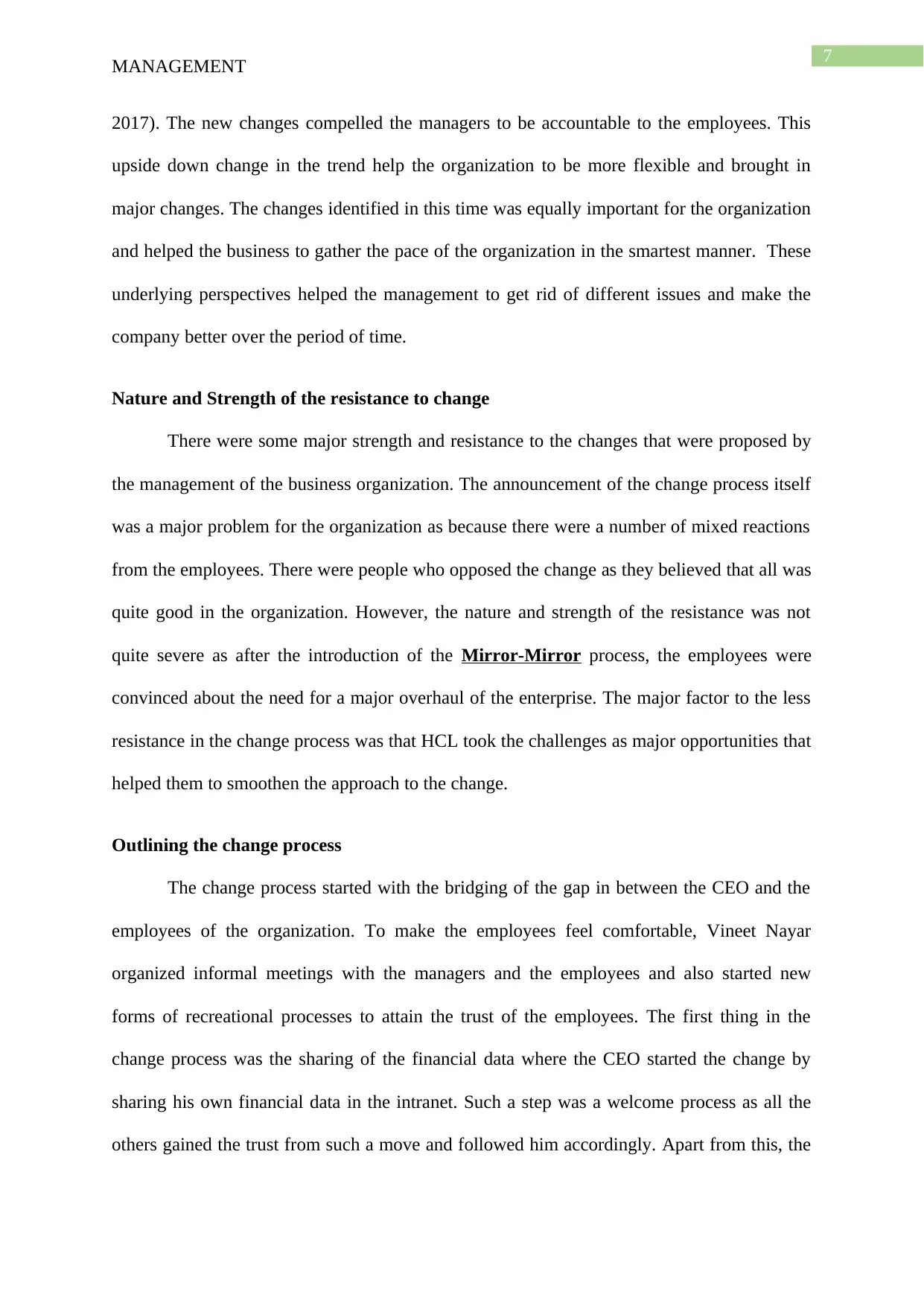
7
MANAGEMENT
2017). The new changes compelled the managers to be accountable to the employees. This
upside down change in the trend help the organization to be more flexible and brought in
major changes. The changes identified in this time was equally important for the organization
and helped the business to gather the pace of the organization in the smartest manner. These
underlying perspectives helped the management to get rid of different issues and make the
company better over the period of time.
Nature and Strength of the resistance to change
There were some major strength and resistance to the changes that were proposed by
the management of the business organization. The announcement of the change process itself
was a major problem for the organization as because there were a number of mixed reactions
from the employees. There were people who opposed the change as they believed that all was
quite good in the organization. However, the nature and strength of the resistance was not
quite severe as after the introduction of the Mirror-Mirror process, the employees were
convinced about the need for a major overhaul of the enterprise. The major factor to the less
resistance in the change process was that HCL took the challenges as major opportunities that
helped them to smoothen the approach to the change.
Outlining the change process
The change process started with the bridging of the gap in between the CEO and the
employees of the organization. To make the employees feel comfortable, Vineet Nayar
organized informal meetings with the managers and the employees and also started new
forms of recreational processes to attain the trust of the employees. The first thing in the
change process was the sharing of the financial data where the CEO started the change by
sharing his own financial data in the intranet. Such a step was a welcome process as all the
others gained the trust from such a move and followed him accordingly. Apart from this, the
MANAGEMENT
2017). The new changes compelled the managers to be accountable to the employees. This
upside down change in the trend help the organization to be more flexible and brought in
major changes. The changes identified in this time was equally important for the organization
and helped the business to gather the pace of the organization in the smartest manner. These
underlying perspectives helped the management to get rid of different issues and make the
company better over the period of time.
Nature and Strength of the resistance to change
There were some major strength and resistance to the changes that were proposed by
the management of the business organization. The announcement of the change process itself
was a major problem for the organization as because there were a number of mixed reactions
from the employees. There were people who opposed the change as they believed that all was
quite good in the organization. However, the nature and strength of the resistance was not
quite severe as after the introduction of the Mirror-Mirror process, the employees were
convinced about the need for a major overhaul of the enterprise. The major factor to the less
resistance in the change process was that HCL took the challenges as major opportunities that
helped them to smoothen the approach to the change.
Outlining the change process
The change process started with the bridging of the gap in between the CEO and the
employees of the organization. To make the employees feel comfortable, Vineet Nayar
organized informal meetings with the managers and the employees and also started new
forms of recreational processes to attain the trust of the employees. The first thing in the
change process was the sharing of the financial data where the CEO started the change by
sharing his own financial data in the intranet. Such a step was a welcome process as all the
others gained the trust from such a move and followed him accordingly. Apart from this, the
Paraphrase This Document
Need a fresh take? Get an instant paraphrase of this document with our AI Paraphraser
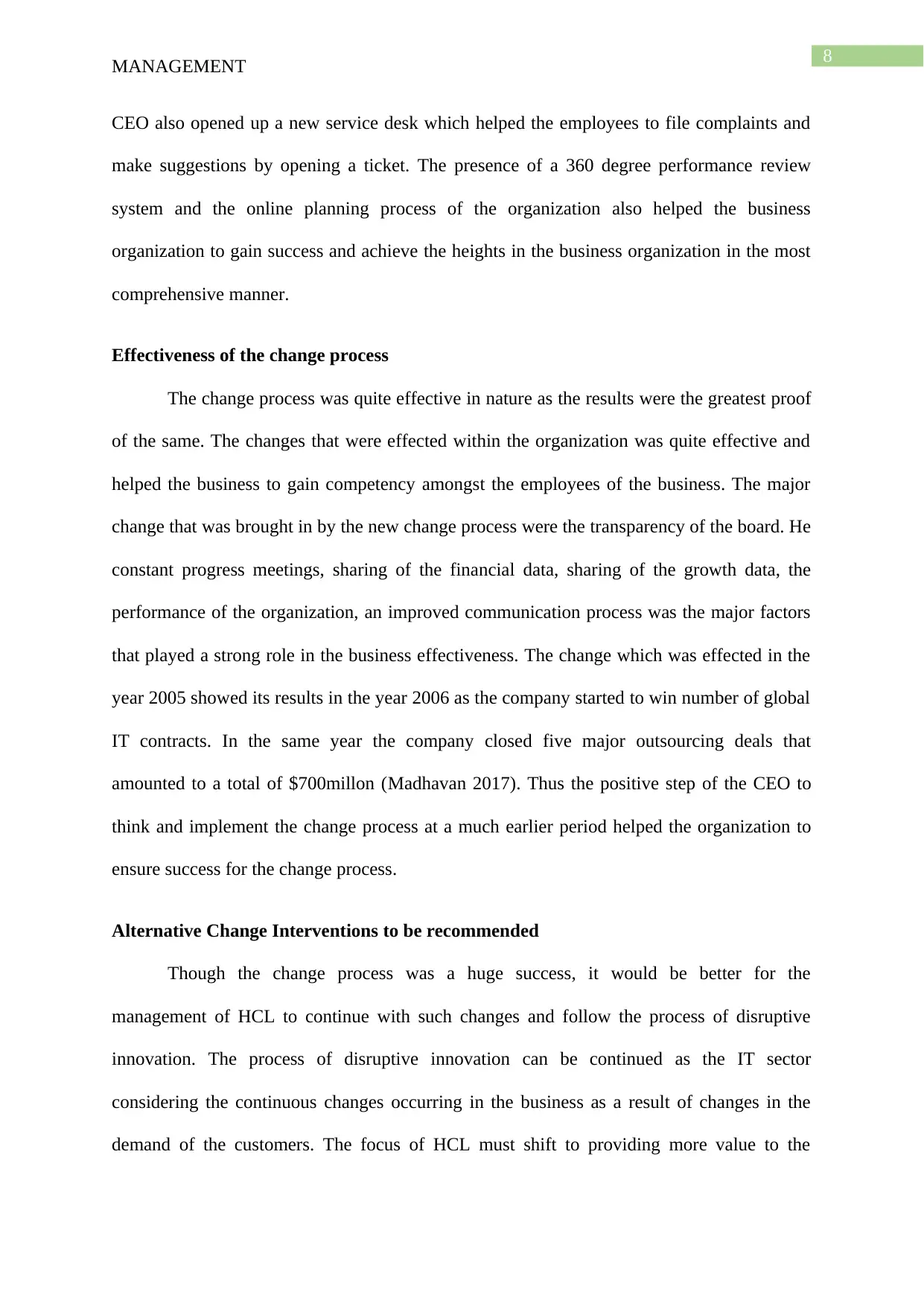
8
MANAGEMENT
CEO also opened up a new service desk which helped the employees to file complaints and
make suggestions by opening a ticket. The presence of a 360 degree performance review
system and the online planning process of the organization also helped the business
organization to gain success and achieve the heights in the business organization in the most
comprehensive manner.
Effectiveness of the change process
The change process was quite effective in nature as the results were the greatest proof
of the same. The changes that were effected within the organization was quite effective and
helped the business to gain competency amongst the employees of the business. The major
change that was brought in by the new change process were the transparency of the board. He
constant progress meetings, sharing of the financial data, sharing of the growth data, the
performance of the organization, an improved communication process was the major factors
that played a strong role in the business effectiveness. The change which was effected in the
year 2005 showed its results in the year 2006 as the company started to win number of global
IT contracts. In the same year the company closed five major outsourcing deals that
amounted to a total of $700millon (Madhavan 2017). Thus the positive step of the CEO to
think and implement the change process at a much earlier period helped the organization to
ensure success for the change process.
Alternative Change Interventions to be recommended
Though the change process was a huge success, it would be better for the
management of HCL to continue with such changes and follow the process of disruptive
innovation. The process of disruptive innovation can be continued as the IT sector
considering the continuous changes occurring in the business as a result of changes in the
demand of the customers. The focus of HCL must shift to providing more value to the
MANAGEMENT
CEO also opened up a new service desk which helped the employees to file complaints and
make suggestions by opening a ticket. The presence of a 360 degree performance review
system and the online planning process of the organization also helped the business
organization to gain success and achieve the heights in the business organization in the most
comprehensive manner.
Effectiveness of the change process
The change process was quite effective in nature as the results were the greatest proof
of the same. The changes that were effected within the organization was quite effective and
helped the business to gain competency amongst the employees of the business. The major
change that was brought in by the new change process were the transparency of the board. He
constant progress meetings, sharing of the financial data, sharing of the growth data, the
performance of the organization, an improved communication process was the major factors
that played a strong role in the business effectiveness. The change which was effected in the
year 2005 showed its results in the year 2006 as the company started to win number of global
IT contracts. In the same year the company closed five major outsourcing deals that
amounted to a total of $700millon (Madhavan 2017). Thus the positive step of the CEO to
think and implement the change process at a much earlier period helped the organization to
ensure success for the change process.
Alternative Change Interventions to be recommended
Though the change process was a huge success, it would be better for the
management of HCL to continue with such changes and follow the process of disruptive
innovation. The process of disruptive innovation can be continued as the IT sector
considering the continuous changes occurring in the business as a result of changes in the
demand of the customers. The focus of HCL must shift to providing more value to the
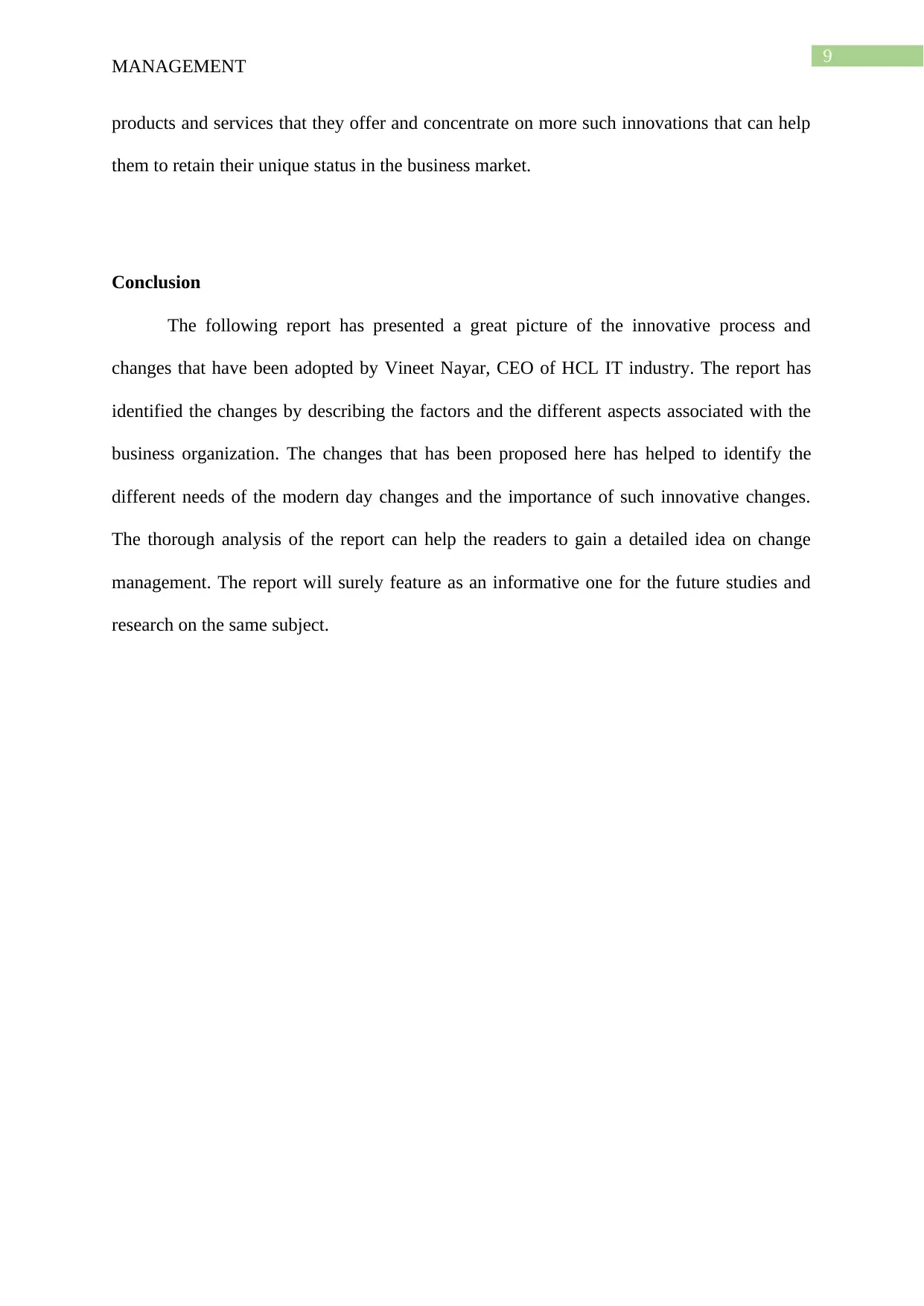
9
MANAGEMENT
products and services that they offer and concentrate on more such innovations that can help
them to retain their unique status in the business market.
Conclusion
The following report has presented a great picture of the innovative process and
changes that have been adopted by Vineet Nayar, CEO of HCL IT industry. The report has
identified the changes by describing the factors and the different aspects associated with the
business organization. The changes that has been proposed here has helped to identify the
different needs of the modern day changes and the importance of such innovative changes.
The thorough analysis of the report can help the readers to gain a detailed idea on change
management. The report will surely feature as an informative one for the future studies and
research on the same subject.
MANAGEMENT
products and services that they offer and concentrate on more such innovations that can help
them to retain their unique status in the business market.
Conclusion
The following report has presented a great picture of the innovative process and
changes that have been adopted by Vineet Nayar, CEO of HCL IT industry. The report has
identified the changes by describing the factors and the different aspects associated with the
business organization. The changes that has been proposed here has helped to identify the
different needs of the modern day changes and the importance of such innovative changes.
The thorough analysis of the report can help the readers to gain a detailed idea on change
management. The report will surely feature as an informative one for the future studies and
research on the same subject.
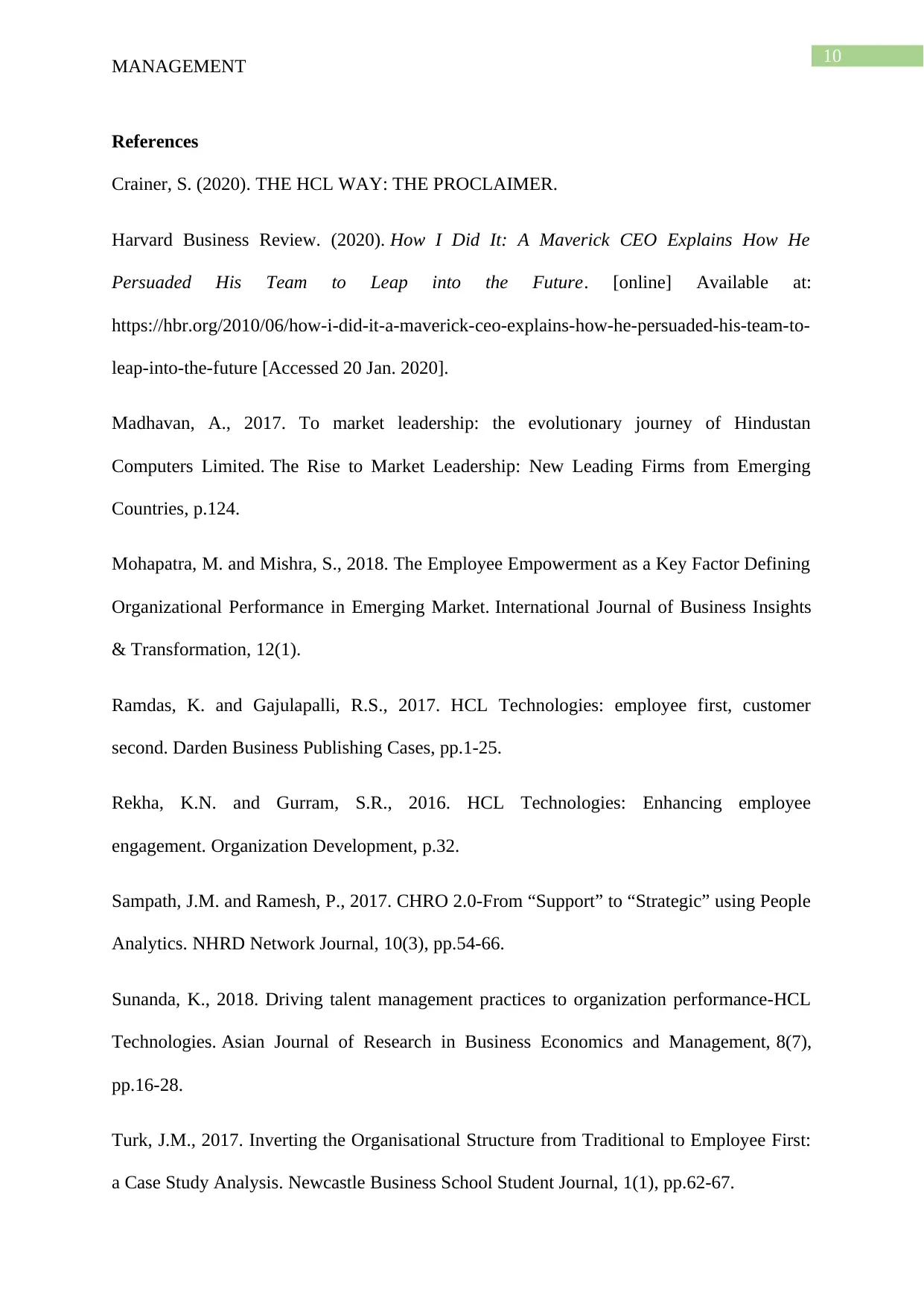
10
MANAGEMENT
References
Crainer, S. (2020). THE HCL WAY: THE PROCLAIMER.
Harvard Business Review. (2020). How I Did It: A Maverick CEO Explains How He
Persuaded His Team to Leap into the Future. [online] Available at:
https://hbr.org/2010/06/how-i-did-it-a-maverick-ceo-explains-how-he-persuaded-his-team-to-
leap-into-the-future [Accessed 20 Jan. 2020].
Madhavan, A., 2017. To market leadership: the evolutionary journey of Hindustan
Computers Limited. The Rise to Market Leadership: New Leading Firms from Emerging
Countries, p.124.
Mohapatra, M. and Mishra, S., 2018. The Employee Empowerment as a Key Factor Defining
Organizational Performance in Emerging Market. International Journal of Business Insights
& Transformation, 12(1).
Ramdas, K. and Gajulapalli, R.S., 2017. HCL Technologies: employee first, customer
second. Darden Business Publishing Cases, pp.1-25.
Rekha, K.N. and Gurram, S.R., 2016. HCL Technologies: Enhancing employee
engagement. Organization Development, p.32.
Sampath, J.M. and Ramesh, P., 2017. CHRO 2.0-From “Support” to “Strategic” using People
Analytics. NHRD Network Journal, 10(3), pp.54-66.
Sunanda, K., 2018. Driving talent management practices to organization performance-HCL
Technologies. Asian Journal of Research in Business Economics and Management, 8(7),
pp.16-28.
Turk, J.M., 2017. Inverting the Organisational Structure from Traditional to Employee First:
a Case Study Analysis. Newcastle Business School Student Journal, 1(1), pp.62-67.
MANAGEMENT
References
Crainer, S. (2020). THE HCL WAY: THE PROCLAIMER.
Harvard Business Review. (2020). How I Did It: A Maverick CEO Explains How He
Persuaded His Team to Leap into the Future. [online] Available at:
https://hbr.org/2010/06/how-i-did-it-a-maverick-ceo-explains-how-he-persuaded-his-team-to-
leap-into-the-future [Accessed 20 Jan. 2020].
Madhavan, A., 2017. To market leadership: the evolutionary journey of Hindustan
Computers Limited. The Rise to Market Leadership: New Leading Firms from Emerging
Countries, p.124.
Mohapatra, M. and Mishra, S., 2018. The Employee Empowerment as a Key Factor Defining
Organizational Performance in Emerging Market. International Journal of Business Insights
& Transformation, 12(1).
Ramdas, K. and Gajulapalli, R.S., 2017. HCL Technologies: employee first, customer
second. Darden Business Publishing Cases, pp.1-25.
Rekha, K.N. and Gurram, S.R., 2016. HCL Technologies: Enhancing employee
engagement. Organization Development, p.32.
Sampath, J.M. and Ramesh, P., 2017. CHRO 2.0-From “Support” to “Strategic” using People
Analytics. NHRD Network Journal, 10(3), pp.54-66.
Sunanda, K., 2018. Driving talent management practices to organization performance-HCL
Technologies. Asian Journal of Research in Business Economics and Management, 8(7),
pp.16-28.
Turk, J.M., 2017. Inverting the Organisational Structure from Traditional to Employee First:
a Case Study Analysis. Newcastle Business School Student Journal, 1(1), pp.62-67.
1 out of 10
Related Documents
Your All-in-One AI-Powered Toolkit for Academic Success.
+13062052269
info@desklib.com
Available 24*7 on WhatsApp / Email
![[object Object]](/_next/static/media/star-bottom.7253800d.svg)
Unlock your academic potential
© 2024 | Zucol Services PVT LTD | All rights reserved.





